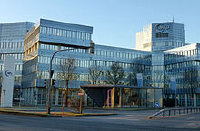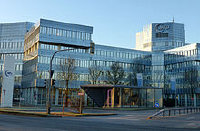
MTU Aero Engines AG
XETRA:MTX


| US |

|
Johnson & Johnson
NYSE:JNJ
|
Pharmaceuticals
|
| US |

|
Berkshire Hathaway Inc
NYSE:BRK.A
|
Financial Services
|
| US |

|
Bank of America Corp
NYSE:BAC
|
Banking
|
| US |

|
Mastercard Inc
NYSE:MA
|
Technology
|
| US |

|
UnitedHealth Group Inc
NYSE:UNH
|
Health Care
|
| US |

|
Exxon Mobil Corp
NYSE:XOM
|
Energy
|
| US |

|
Pfizer Inc
NYSE:PFE
|
Pharmaceuticals
|
| US |

|
Palantir Technologies Inc
NYSE:PLTR
|
Technology
|
| US |

|
Nike Inc
NYSE:NKE
|
Textiles, Apparel & Luxury Goods
|
| US |

|
Visa Inc
NYSE:V
|
Technology
|
| CN |

|
Alibaba Group Holding Ltd
NYSE:BABA
|
Retail
|
| US |

|
3M Co
NYSE:MMM
|
Industrial Conglomerates
|
| US |

|
JPMorgan Chase & Co
NYSE:JPM
|
Banking
|
| US |

|
Coca-Cola Co
NYSE:KO
|
Beverages
|
| US |

|
Walmart Inc
NYSE:WMT
|
Retail
|
| US |

|
Verizon Communications Inc
NYSE:VZ
|
Telecommunication
|
Utilize notes to systematically review your investment decisions. By reflecting on past outcomes, you can discern effective strategies and identify those that underperformed. This continuous feedback loop enables you to adapt and refine your approach, optimizing for future success.
Each note serves as a learning point, offering insights into your decision-making processes. Over time, you'll accumulate a personalized database of knowledge, enhancing your ability to make informed decisions quickly and effectively.
With a comprehensive record of your investment history at your fingertips, you can compare current opportunities against past experiences. This not only bolsters your confidence but also ensures that each decision is grounded in a well-documented rationale.
Do you really want to delete this note?
This action cannot be undone.

| 52 Week Range |
193.8
327.6
|
| Price Target |
|
We'll email you a reminder when the closing price reaches EUR.
Choose the stock you wish to monitor with a price alert.

|
Johnson & Johnson
NYSE:JNJ
|
US |

|
Berkshire Hathaway Inc
NYSE:BRK.A
|
US |

|
Bank of America Corp
NYSE:BAC
|
US |

|
Mastercard Inc
NYSE:MA
|
US |

|
UnitedHealth Group Inc
NYSE:UNH
|
US |

|
Exxon Mobil Corp
NYSE:XOM
|
US |

|
Pfizer Inc
NYSE:PFE
|
US |

|
Palantir Technologies Inc
NYSE:PLTR
|
US |

|
Nike Inc
NYSE:NKE
|
US |

|
Visa Inc
NYSE:V
|
US |

|
Alibaba Group Holding Ltd
NYSE:BABA
|
CN |

|
3M Co
NYSE:MMM
|
US |

|
JPMorgan Chase & Co
NYSE:JPM
|
US |

|
Coca-Cola Co
NYSE:KO
|
US |

|
Walmart Inc
NYSE:WMT
|
US |

|
Verizon Communications Inc
NYSE:VZ
|
US |
This alert will be permanently deleted.
 MTU Aero Engines AG
MTU Aero Engines AG
MTU Aero Engines AG
Investor Relations
MTU Aero Engines AG, Germany's premier engine manufacturer, sits at the crossroads of innovation and precision engineering in the global aviation industry. Founded in 1934, the company has evolved through decades of technological advancements and market shifts to become a pivotal player in the aerospace sector. Central to MTU's operations is its prowess in the design, development, and manufacturing of aircraft engines — a business that thrives on both cutting-edge research and meticulous engineering. By collaborating with major international players like Pratt & Whitney and GE Aviation, MTU ensures that its engines power a significant portion of commercial and military aircraft worldwide. This collaboration extends into programs such as the Pratt & Whitney's geared turbofan engine, where MTU's contributions are indispensable in crafting superior propulsion systems.
Financially, MTU Aero Engines AG derives its revenue from a triad of core operations: original equipment manufacturing (OEM) for commercial and military engines, the provision of maintenance, repair, and overhaul (MRO) services, and participation in power generation and gas turbine engines. The OEM segment capitalizes on MTU's engineering expertise, providing robust engines and key components that meet the stringent demands of modern aviation. Meanwhile, the MRO services highlight MTU's strategic insight; as aircraft engines require regular upkeep and enhancement, this segment guarantees a steady revenue stream. The nexus of these activities allows MTU to maintain an agile business model while spearheading innovations that define the future landscape of aviation propulsion technology.

MTU Aero Engines AG, Germany's premier engine manufacturer, sits at the crossroads of innovation and precision engineering in the global aviation industry. Founded in 1934, the company has evolved through decades of technological advancements and market shifts to become a pivotal player in the aerospace sector. Central to MTU's operations is its prowess in the design, development, and manufacturing of aircraft engines — a business that thrives on both cutting-edge research and meticulous engineering. By collaborating with major international players like Pratt & Whitney and GE Aviation, MTU ensures that its engines power a significant portion of commercial and military aircraft worldwide. This collaboration extends into programs such as the Pratt & Whitney's geared turbofan engine, where MTU's contributions are indispensable in crafting superior propulsion systems.
Financially, MTU Aero Engines AG derives its revenue from a triad of core operations: original equipment manufacturing (OEM) for commercial and military engines, the provision of maintenance, repair, and overhaul (MRO) services, and participation in power generation and gas turbine engines. The OEM segment capitalizes on MTU's engineering expertise, providing robust engines and key components that meet the stringent demands of modern aviation. Meanwhile, the MRO services highlight MTU's strategic insight; as aircraft engines require regular upkeep and enhancement, this segment guarantees a steady revenue stream. The nexus of these activities allows MTU to maintain an agile business model while spearheading innovations that define the future landscape of aviation propulsion technology.





























 You don't have any saved screeners yet
You don't have any saved screeners yet
